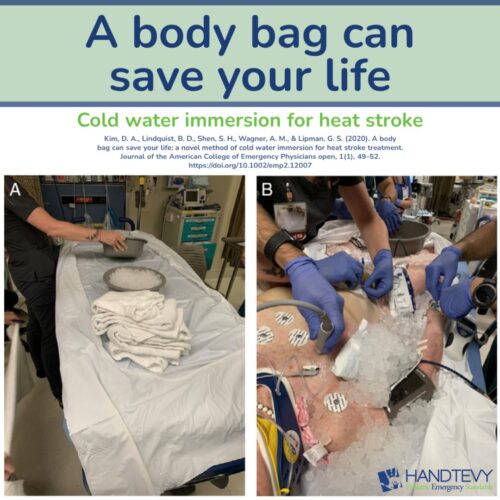A Novel Method for Heat Stroke Treatment Using a Body Bag

There are 2 types of heat stroke:
➊ Non-exertional (think elderly patient)
➋ Exertional (think athlete)
Both need immediate cooling, by EMS ideally. But how can we do this effectively in the field?
“Can someone bring me the body bag?”
A case study was just published involving an 87-year-old woman found unconscious in a parking lot an oral temperature of 40◦C (104◦F) and an altered mental status. EMS initiated cooling by application of chemical cold packs applied to the patient’s skin during transport. At arrival to the ED, the hospital bed was prepared with a body bag, buckets of ice, and water.
Background:
Heat stroke is a severe medical condition with in-hospital mortality rates reaching up to 33%. Between 1999 and 2010, the US averaged 618 heat-related deaths annually. With climate models predicting more frequent and severe heatwaves, emergency departments must be prepared with effective treatment methods for heat stroke. Non-exertional heat stroke is particularly common among the elderly, who may have impaired thermoregulation due to various factors.
Case Report:
The study discusses the case of an 87-year-old woman found unconscious in a parking lot during a record-setting regional heat wave. She had an oral temperature of 40°C (104°F) and altered mental status. Due to the immediate need for rapid cooling, the team used a waterproof body bag filled with ice and water for cold water immersion. Within 10 minutes, the patient’s temperature dropped to 38.4°C (101.1°F), and her mental status normalized. She was subsequently discharged from the emergency department in stable condition.
Discussion:
Cold water immersion is considered the gold standard for rapid cooling in cases of exertional heat stroke. It provides faster cooling rates compared to evaporative or convective cooling methods. However, implementing cold water immersion in emergency departments can be logistically challenging. The use of a body bag for this purpose offers several advantages:
- Cost-Effective: Body bags are inexpensive (generally less than $25) compared to conventional full-body cold water tubs.
- Convenient: Body bags are readily available in hospitals, easy to prepare, and scalable for mass casualty incidents.
- Efficient: The body bag retains all the ice and water, ensuring effective cooling without spillage.
It’s safe to say that EMS and ED clinicians should starting think outside the box (and inside the bag ) on their next heat stroke emergency!
Wondering how to do this in the field? The water temperature from most fire hydrants is 55◦F which now gives us one more reason to use them…..this time for patient care!
Read the study here: http://ow.ly/Lnpm50LHvTf

Peter Antevy, MD
Source: Kim, D.A., Lindquist, B.D., Wagner, A.M., Shen, S.H., & Lipman, G.S. (2020). A body bag can save your life: a novel method of cold water immersion for heat stroke treatment. JACEP Open, 1, 49-52.
DISCLAIMER:Pediatric Emergency Standards Inc. does not make clinical or medical decisions. The Handtevy System is intended to be utilized as a guide only. Provider’s experience and training should be the final determinant of clinical treatment decisions.

